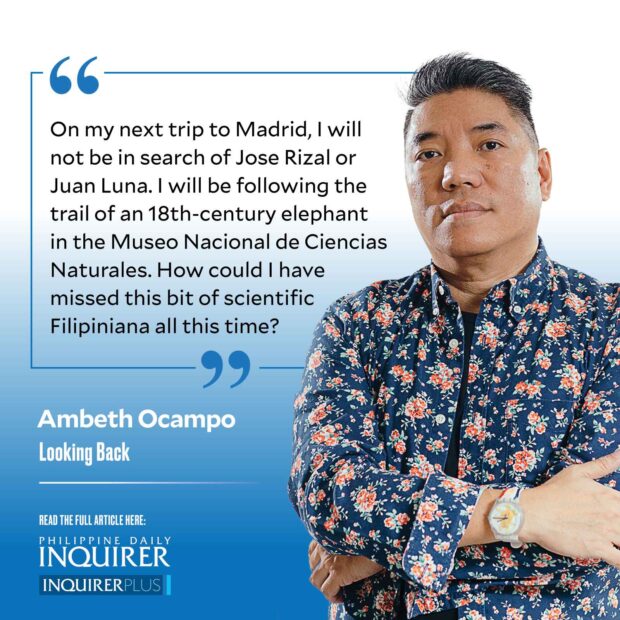An elephant from 1700s PH in Madrid
 On my next trip to Madrid, I will not be in search of Jose Rizal or Juan Luna. I will be following the trail of an 18th-century elephant in the Museo Nacional de Ciencias Naturales. How could I have missed this bit of scientific Filipiniana all this time?
On my next trip to Madrid, I will not be in search of Jose Rizal or Juan Luna. I will be following the trail of an 18th-century elephant in the Museo Nacional de Ciencias Naturales. How could I have missed this bit of scientific Filipiniana all this time?
Years of library and archival research taught me never to judge books by their covers. Rizal’s unfinished third novel, “Makamisa,” was lost to us for almost a century because it was mislabeled, by a prewar librarian, as the “Borrador del Noli me tangere.” Ignored by previous researchers as mere drafts of the “Noli,” the 245-page manuscript turned out to be the beginning of another work. The other thing I learned from hands-on experience with Spanish sources is never to judge a book or document by reading only half of its kilometric titles. Try this one:
“Descripcion del elefante, de su alimento, costumbres, enemigos, e institnto; y explicacion del uso que se hace de los elefantes, modo de cazarlos, y utilidades de sus Colmillos en la Medicina, y en los Artes, &c, Sacado de varios autores de Historia Natural, y añadida una noticia circunstanciada del que se ha remitido de Philipinas para el Rey nuestro Señor. Con licencia. En Madrid en la Impresa de Andres Ramirez, called de la Magdalena, año de 1773. Se hallara en la Libreria de Miguel Escribano, calle de las Carretas.”Having survived natural science in college by the skin of my teeth, I wasn’t too keen on this rare book on elephants: description, their diet, customs, enemies, mating, and the use of their fangs and tusks in medicine and the arts. Published in Madrid in 1773, the work has some natural history Filipiniana. An elephant was sent to Spain from Manila, a recycled gift of the governor general of the Philippines to Spanish King Carlos III. This elephant is preserved in the Museum of Natural History in Madrid.
On Jan. 23, 1773, the frigate Venus set sail for Spain from Manila with precious cargo, or should I say a VIP guest, an elephant whose name is lost to history. I wouldn’t be surprised if the elephant was stressed by its cramped quarters during the 179-day voyage. It arrived in Cadiz on July 24, 1773. In preparing the elephant for the formal presentation to Carlos III, the poor thing was exposed to cannon fire before leaving Manila, to accustom it to noise and the smell of gunpowder. The elephant was sourced from the Coromandel Coast, a gift from Muhammad Ali Khan Walla Jah of Arcot, a principality south of India, to Simon de Anda y Salazar, governor and captain general of Filipinas, president of the Royal Audiencia of Manila, who is better known for a monument on Bonifacio Drive erected as a memorial for his resistance during the British Occupation of Manila from 1762 to 1764.
The elephant was described as being five and a half years old, with a trunk whose length was measured at four feet and three inches (the Spanish foot in the 18th century being approximately 28 centimeters); its height was six feet and five inches, distance from ears to the tail at seven feet and one inch. During the sea voyage, it subsisted on a daily ration of 85 cuartillos (approximately half a liter) of water, 24 pounds (approximately 460 grams) of rice, six pounds of sugar, two and a half rations of bread, and four bunches of bananas. The grass was also kept fresh on board for its meals. Two “cornacas” or elephant minders from the Malabar Coast were entrusted with its care.
This was not the first of Carlos III’s elephants. His first was received in 1740 as a gift from a Turkish sultan when he was still king of Naples. To make the elephant fit for presentation to Carlos III and his court assembled in the Real Sitio de San Ildefonso on Sept. 26, 1773, a vestment of gold thread ornamented with hangings and bells was ordered for it. Shoes were also made for its big feet. It survived the long journey from Manila and was eventually sent to the Real Sitio de Aranjuez where it lived until the end of 1777. After its death, the Count of Floridablanca ordered the corpse sent to the taxidermist who did so well a job it can still be seen in the National Museum of Natural Sciences in Madrid. This may be an insignificant footnote in Spanish-Philippine history, but someone should write up all the animals, birds, reptiles, and other curiosities that made their way to Spain from the Philippines.
Comments are welcome at aocampo@ateneo.edu
















